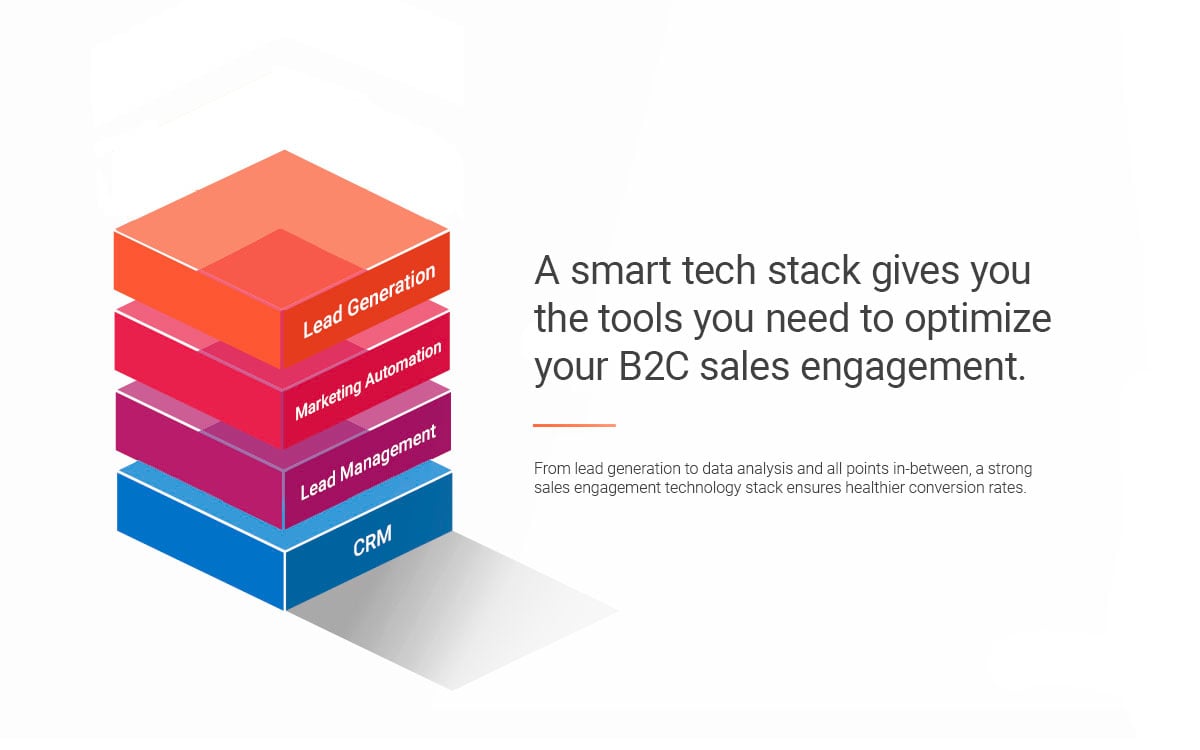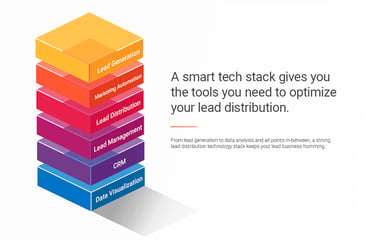4 Essential Software Tools for Your Sales Tech Stack
What is a sales tech stack, and why do I need it?
Effective modern sales require less time working on mundane manual tasks and more time engaging directly with sales prospects.
There are many software tools to consider when building a start-to-finish digital marketing process. How do you get from generating a lead to making a sale most efficiently?
A sales technology stack (sales tech stack) is an ecosystem of sales software applications. This ecosystem moves a lead seamlessly to a closed sale. Think of it as a digital toolbox.
A one-size-fits-all CRM is appealing, but the best CRMs also have the most integrations for a reason. CRMs are only one component of an effective sales tech stack.
With automation and integration, companies achieve sales efficiency that keeps pace with the rapid changes in consumer buying habits and expectations. Building a sales tech stack requires evaluating the available software and how it fits into the sales process. It's also necessary to look at how well it fits your business requirements.
Sales leaders at top organizations align marketing and sales teams, achieving a more fluid path to a closed deal. Marketing generates leads but also helps qualify and nurture them. Suppose salespeople aren’t successful in converting a prospect; marketing assists in promoting and re-engaging that lead. This makes marketing automation a vital part of the sales tech stack.
When building a start-to-finish digital sales process, there are many considerations:
- How do you get from generating a lead to making a sale most efficiently?
- How do you ensure the automation of your prospects and leads to sales reps?
- How do you match opportunities in your sales pipeline with the right salespeople?
- How do you implement sales and marketing programs without technical roadblocks that prevent customers from completing their buyer’s journey?

Modern sales teams need different solutions to complete their sales tech toolkit, and they all need to talk to one another. More specialized sales enablement tools for every stage of business launch daily. Using a portfolio of software applications to build a sales process to convert more qualified leads can seem overwhelming. However, when carefully chosen, these integrated solutions allow a higher ability to customize, allowing sales teams to adapt, evolve, and succeed.
A complete sales enablement software technology stack will include:
A complete sales enablement tech stack might look like this:
Lead Generation
Lead generation software provides marketers with tools to generate leads. Landing pages, text chat, and phone calls are used to capture lead data. Cold email, PPC, and SEO drive prospects to your website or landing pages.
These prospects engage via live chat, conversion form, or inbound calls. Lead generation sends lead data in real-time to marketing automation for nurturing and lead qualifying, lead distribution, or lead management.
Marketers either use one-off marketing automation software that is very good at specific tasks or applications that include many tools.
A marketing technology stack for lead generation might include:
- SEO - Moz, Semrush
SEO tools help marketing teams assess inbound links and website performance with Google and other search engines. They also help create web pages with targeted keywords to maximize site rankings.
- Email - Hubspot, Snov.io
Email marketing applications create and evaluate email campaigns. They manage cold outreach and nurture drips that target your customers at the right time in their customer journey. Email marketing applications should include email templates and email scheduling features.
- PPC - Google Ads
Pay Per Click solutions generate link clicks, driving traffic to your website for lead capture.
- Retargeting - Adroll
Solutions like Adroll track web visitors and target them with relevant ads on other websites.
Why do I need lead generation software?
Organizations either run internal lead generation programs or hire agencies to generate their leads. Lead-gen agencies are very effective in the short term. Long-term strategies should include internal lead-gen using lead generation software. Internal lead generation allows for tighter lead quality control and reduced costs.
Without internal lead generation programs, companies are entirely dependent on lead generation agencies, which can be very costly over time. Generating leads both in-house and through agencies is a smart strategy for the best ROI on customer acquisition.
Once leads are generated, they need to be organized and tracked. leads are sent to marketing automation software or directly to a lead management platform. Lead management allows businesses to store and manage their leads in one central location.
Marketing Automation
Marketing automation software frees marketing teams of day-to-day manual tasks and lead qualification. By managing the execution of direct tasks, it allows marketers to focus on strategic initiatives. This allows marketing to focus on content creation and creative problem-solving. Marketing automation can reduce human error and makes campaigns more effective.
Marketing automation platforms accept incoming leads from various sources, including managed ads, landing pages, emails, or sales software. Most marketing automation solutions also help track the effectiveness of lead generation efforts. Marketing automation helps manage contacts and segment, score, prioritize, and nurture them to the marketing qualified lead (MQL) stage.
Once leads are qualified, they forward to a sales application. Marketing automation often includes creating and tracking landing page performance, email campaigns, PPC, SEO, and managing ad spending.
Why do I need marketing automation?
Marketing automation provides a single tool to manage social media campaigns, email nurture campaigns, SEO efforts, and PPC. All of these features increase the efficiency of marketing departments. By automating these marketing efforts, your team becomes more efficient.
Popular marketing automation solutions include Hubspot, Marketo, and Pardot.
Lead Management (Sales Automation Software)
Lead management software is the core of any sales technology stack that involves lead follow-up. Automating sales processes is at the heart of lead management software. A sales automation platform like ClickPoint LeadManager accepts the lead data when it’s sales-ready and applies intelligent lead routing. Here it is prioritized, routed, tracked, and available for calling, texting, and emailing.
The next step in lead management is nurturing. Nurturing builds relationships with leads, and helps them understand how your products or services can benefit them. This can be done through personalized emails, targeted content, or phone calls.
Once leads are nurtured and ready to make a purchase decision, they move to the sales engagement phase. Leads are guided through the sales process, educated about the product, and provided with enough information to make an informed decision.
Lead management doesn't end once a lead is converted into a customer. Ongoing engagement and support is important to retain customers and turn them into loyal, long-term supporters of your business. This can be done through regular communication, providing excellent customer service, and offering ongoing support and resources. Customers at this stage are often sent to CRM software.
Why do I need lead management?
Some companies rely solely on CRMs to close leads. CRMs be inefficient in some areas, a problem that lead management software addresses. Lead management handles many prospects and leads, segments sales channels, and focuses on top-of-funnel activities. As a sales engagement tool, it directly helps sales teams convert more prospects.
Lead management solutions prioritize leads across large organizations with multiple locations. Lead management moves hot prospects through custom sales cadences. These cadences include email, text, dialing, and chat, all from a straightforward, purpose-built tool. A good lead management platform can dramatically increase contact rates, increase closed deals, decrease CPA, and boost ROI.
CRM
Customer relationship management (CRM) manages all your company's interactions with prospects and customers. CRMs exist to build and improve customer relationships and thereby grow your business.
While there are different types of CRM platforms, they are generally designed to help prioritize sales and retention opportunities. They excel at middle of funnel to bottom of funnel activity and customer service. CRM systems often have sales automation features. However, CRMs as sales tools are most effective when integrated with marketing automation and lead management applications.
Why do I need a CRM?
CRM software is essential for the post-contact pipeline. A good CRM helps you organize your channel, get orders to customers, and track the progress of orders against your pipeline.
Popular CRM systems include Salesforce, Hubspot, Zoho, Pipedrive, and Insightly.
Summary
By customizing your tech stack to include marketing and sales with intelligent integrations, you make your business technology work for you. A well-thought-out sales and marketing tech stack will optimize your sales for more substantial conversions and ROI.





